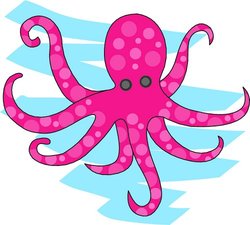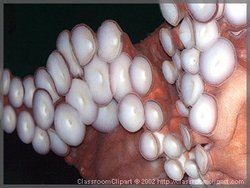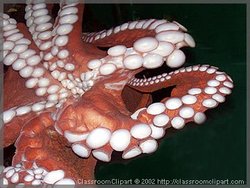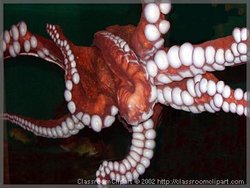Octopus
|
|
| Octopus | ||||||||||||
|---|---|---|---|---|---|---|---|---|---|---|---|---|
 | ||||||||||||
| Scientific classification | ||||||||||||
| ||||||||||||
| Families | ||||||||||||
|
14 in two suborders, see text. |
The octopus is a cephalopod of the order Octopoda that inhabits many diverse regions of the ocean, especially coral reefs. The term may also refer to only those creatures in the genus Octopus. In the larger sense, there are 289 different octopus species, which is over one-third the total number of cephalopod species.
Octopuses are characterized by their eight arms, usually with sucker cups on them. Unlike most other cephalopods, the majority of octopuses — those in the suborder most commonly known, Incirrina — have almost entirely soft bodies; they have neither a protective outer shell like the nautilus, nor any vestige of an internal shell or bones, like cuttlefish or squids. A beak, similar in shape to a parrot's beak, is their only hard part. This enables them to squeeze through very narrow slits between underwater rocks, which is very helpful when they are fleeing from morays or other predating fish. The octopuses in the less familiar Cirrina suborder have two fins and an internal shell, making them a little less flexible in being able to squeeze into small spaces.
Three defensive mechanisms are typical of octopuses: ink sacs, camouflage, and autonomising limbs. Most octopuses can eject a thick blackish ink in a large cloud to aid in escaping from predators. They also have specialized skin cells both for color changing (chromatophores) and light reflection and refraction (iridophores and leucophores). They use this ability to blend into the environment to hide, as communication with other octopuses, or as a warning: the very poisonous Blue-ringed Octopus becomes bright yellow with blue rings when it is provoked. When under attack, some octopuses can detach and autonomise their limbs, in a similar manner to skinks and other lizards. The crawling arm serves as a distraction to would-be predators; this ability is also used in mating. A few species have a fourth defense mechanism, in that they can combine their highly flexible bodies with their color changing ability to accurately mimic other, more dangerous animals such as lionfish and eels.
When octopuses reproduce, they use a specialized arm called a hectocotylus to insert spermatophores (packets of sperm) into the female's mantle cavity. The hectocotylus is usually the third right arm. In some species, the female octopus can keep the sperm alive inside her for weeks until her eggs are mature. After they have been fertilized, the female lays roughly 200,000 eggs (this figure dramatically varies between species). The female hangs these eggs in strings from the ceiling of her lair. After the eggs hatch, the young larval octopuses must spend a period of time drifting in clouds of plankton, where they feed on copepods, larval crabs and larval seastars until they are ready to sink down to the bottom of the ocean, where the cycle repeats itself (in some deeper dwelling species, the young don't go through this period). This is a dangerous time for the larval octopuses, however, as they become part of the plankton cloud and are therefore preyed upon by the many other plankton eaters.
Octopuses have a relatively short life span, and some species live for as little as six months. Larger species, such as the North Pacific Giant Octopus, may live for up to five years if they do not reproduce. However, reproduction is a cause of death: males can only live for a few months after mating, and females die shortly after their eggs hatch, for they spend nearly all their time caring for their eggs during the roughly one month period it takes the eggs to hatch, and do not eat during this period.
Octopus blood contains the copper-rich protein hemocyanin for transporting oxygen. Less efficient than the iron-rich hemoglobin of vertebrates, the hemocyanin is dissolved in the plasma instead of being bound in red blood cells and gives the blood a blue color.
| Contents |
Intelligence
Octopuses are highly intelligent, probably the most intelligent of the invertebrates. Maze and problem-solving experiments show that they have both short- and long-term memory, although their short lifespans limit the amount they can ultimately learn.
An octopus has a highly complex nervous system, only part of which is localized in its brain. Two-thirds of an octopus's neurons are found in the nerve cords of its arms, which have a remarkable amount of autonomy. Octopus arms show a wide variety of complex reflex actions arising on at least three different levels of the nervous system.
In laboratory experiments, octopuses can be readily trained to distinguish between different shapes and patterns. They are able to open jars after learning from observation [1] (http://news.bbc.co.uk/2/hi/europe/2796607.stm). Octopuses have also been engaged in what may be described as play; repeatedly releasing bottles or toys into a circular current in their aquariums and then catching them. Octopuses often break out of their aquariums (and sometimes into others) in search of food. They have even boarded fishing ships and opened holds to eat crabs.
In many countries, including the United States and the United Kingdom, octopuses are on the list of experimental animals on which surgery may not be performed without anesthesia.
Sensation
Octopuses have keen eyesight. Although their slit-shaped pupils might be expected to afflict them with astigmatism, it appears that this is not a problem in the light levels in which an octopus typically hunts. Surprisingly, they do not appear to have color vision, although they can distinguish the polarization of light. Attached to the brain are two special organs, called statocysts, that allow the octopus to sense the orientation of its body relative to horizontal. An autonomic response keeps the octopus's eyes oriented so that the pupil slit is always horizontal.
Octopuses also have an excellent sense of touch. The octopus's suckers are equipped with chemoreceptors so that the octopus can taste what it is touching. The arms contain tension sensors so that the octopus knows whether its arms are stretched out. Surprisingly, however, the octopus has a very poor proprioceptive sense. The tension receptors are not sufficient for the octopus brain to determine the position of the octopus's body or arms. (It is not clear that the octopus brain would be capable of processing the large amount of information that this would require; in vertebrates, the brain needs to process only the position of the joints; in contrast the position of an octopus's arms is much more variable.) As a result, the octopus does not seem to form a mental image of the overall shape of the object it is handling. It can detect local texture variations, but cannot integrate the information into a larger picture.
The neurological autonomy of the arms means that the octopus has great difficulty learning about the detailed effects of its motions. The brain may issue a high-level command to the arms, but the nerve cords in the arms execute the details. There is no neurological path for the brain to receive feedback about just how its command was executed by the arms; the only way it knows just what motions were made is by observing the arms visually. It is sometimes said that octopuses can "learn" to open jars, but this appears to be incorrect. The only thing that octopuses appear to be capable of learning about opening jars is to be persistent and vigorous.
Locomotion
In 2005 it was reported that some octopuses can walk on two arms on a solid surface, while at the same time imitating a coconut or a clump of seaweed (see 'Science', vol. 307, p. 1927 (http://www.sciencemag.org/cgi/content/full/307/5717/1927), including short movies).
Miscellaneous
Though octopuses can be hard to keep in captivity, some people keep them as pets. Octopuses often escape, however, even from supposedly secure tanks, due to their intelligence and problem solving skills. The variation in size and life span among octopus species makes it difficult to know how long a new specimen can naturally be expected to live. That is, a small octopus may be just born or may be an adult, depending on the species. By selecting a well-known species, such as the California Two-spot Octopus, one can choose a small octopus (around the size of a tennis ball) and be confident that it is young with a full life ahead of it.
A common belief is that when stressed, an octopus may begin to eat itself. However, limited research conducted in this area has revealed that the cause of this abnormal behaviour may be due to a virus that attacks the octopus's nervous system, thus this behaviour is more correctly labeled as a mental disease.
Plural
A note on the plural form: Fowler's Modern English Usage states that "the only acceptable plural in English is octopuses", and that octopi is misconceived and octopodes pedantic. Octopi derives from the mistaken notion that octopus is Latin. It is not. It is (Latinized) Greek, from oktopous Template:Polytonic, gender masculine, whose plural is oktopodes (ὀκτώποδες). If the word were Latin, it would be octopes ('eight-foot') and the plural octopedes, analogous to centipedes and millipedes, as the plural form of pes ('foot') is pedes. In modern, informal Greek, it is called khtapodi Template:Polytonic, gender neuter, with plural form khtapodia Template:Polytonic.
That said, Merriam-Webster and other dictionaries accept octopi as a plural form. The Oxford English Dictionary lists octopuses, octopi, and octopodes (the order reflecting decreasing frequency of use), stating that the last form is rare. The term octopod (either plural octopods and octopodes can be found) is taken from the taxonomic order octopoda but has no classical equivalent. The collective form octopus is usually reserved for animals consumed for food. Finally worth mentioning is Octopussy, a play on words which found its way back from the movie title to a term of endearment for the animals that have originally inspired it.
Classification
- CLASS CEPHALOPODA
- Subclass Nautiloidea: nautilus
- Subclass Coleoidea
- Superorder Decapodiformes: squid, cuttlefish
- Superorder Octopodiformes
- Order Vampyromorphida: Vampire Squid
- Order Octopoda
- Suborder Cirrina: finned deep-sea octopus
- Family Cirroteuthidae
- Family Grimpoteuthididae
- Family Luteuthididae: Lu's Jellyhead
- Family Opisthoteuthidae: umbrella octopus
- Family Stauroteuthidae
- Suborder Incirrina
- Family Alloposidae: Seven-arm Octopus
- Family Amphitretidae: telescope octopus
- Family Argonautidae: argonauts
- Family Bolitaenidae: gelatinous octopus
- Family Idioctopodidae
- Family Octopodidae: benthic octopus
- Family Ocythoidae: Tuberculate Pelagic Octopus
- Family Tremoctopodidae: blanket octopus
- Family Vitreledonellidae: Glass Octopus
- Suborder Cirrina: finned deep-sea octopus



